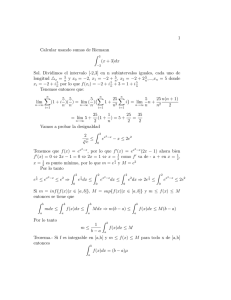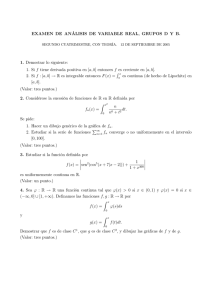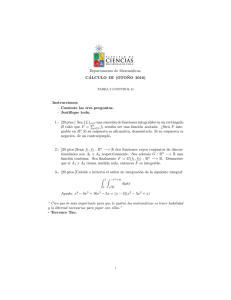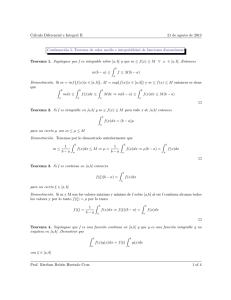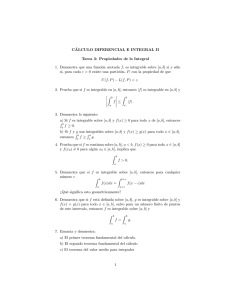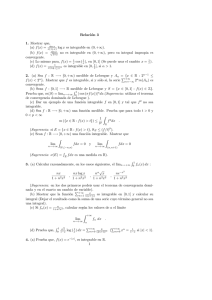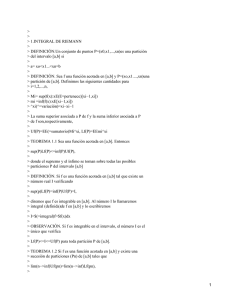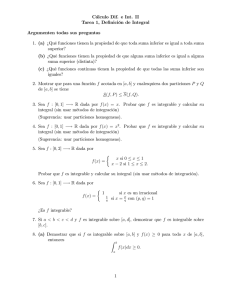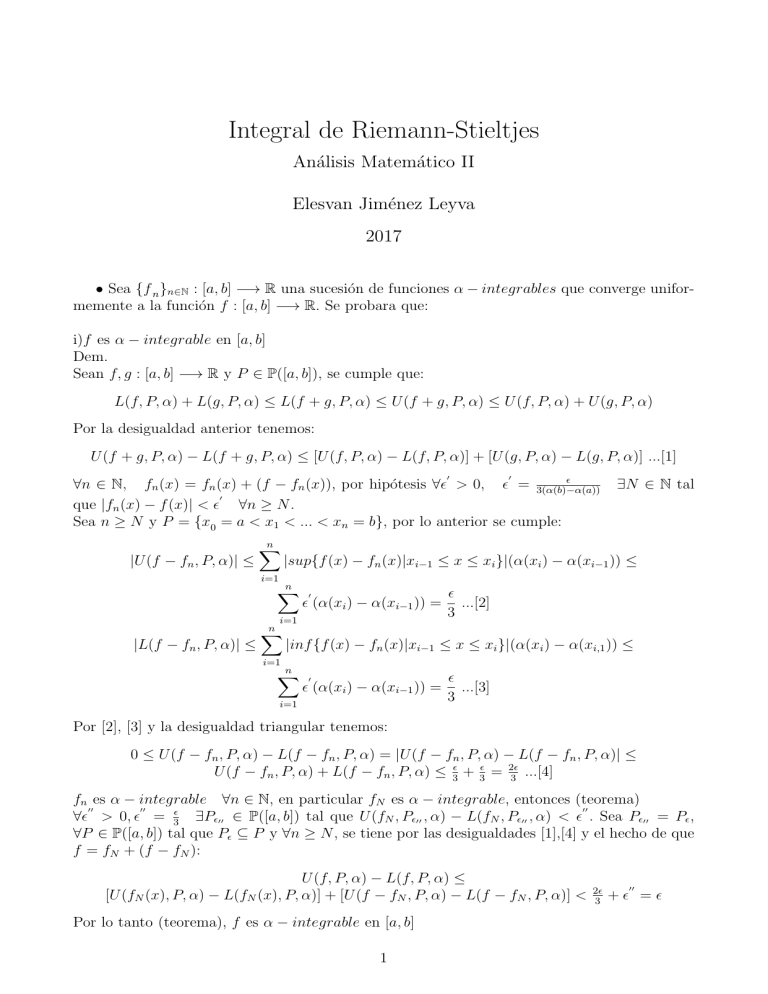
Integral de Riemann-Stieltjes
Análisis Matemático II
Elesvan Jiménez Leyva
2017
• Sea {f n }n∈N : [a, b] −→ R una sucesión de funciones α − integrables que converge uniformemente a la función f : [a, b] −→ R. Se probara que:
i)f es α − integrable en [a, b]
Dem.
Sean f, g : [a, b] −→ R y P ∈ P([a, b]), se cumple que:
L(f, P, α) + L(g, P, α) ≤ L(f + g, P, α) ≤ U (f + g, P, α) ≤ U (f, P, α) + U (g, P, α)
Por la desigualdad anterior tenemos:
U (f + g, P, α) − L(f + g, P, α) ≤ [U (f, P, α) − L(f, P, α)] + [U (g, P, α) − L(g, P, α)] ...[1]
0
0
∀n ∈ N, fn (x) = fn (x) + (f − fn (x)), por hipótesis ∀ > 0, = 3(α(b)−α(a))
0
que |fn (x) − f (x)| < ∀n ≥ N .
Sea n ≥ N y P = {x0 = a < x1 < ... < xn = b}, por lo anterior se cumple:
|U (f − fn , P, α)| ≤
n
X
∃N ∈ N tal
|sup{f (x) − fn (x)|xi−1 ≤ x ≤ xi }|(α(xi ) − α(xi−1 )) ≤
i=1
n
X
0
(α(xi ) − α(xi−1 )) =
i=1
|L(f − fn , P, α)| ≤
n
X
...[2]
3
|inf {f (x) − fn (x)|xi−1 ≤ x ≤ xi }|(α(xi ) − α(xi,1 )) ≤
i=1
n
X
0
(α(xi ) − α(xi−1 )) =
i=1
...[3]
3
Por [2], [3] y la desigualdad triangular tenemos:
0 ≤ U (f − fn , P, α) − L(f − fn , P, α) = |U (f − fn , P, α) − L(f − fn , P, α)| ≤
U (f − fn , P, α) + L(f − fn , P, α) ≤ 3 + 3 = 23 ...[4]
fn es α − integrable ∀n ∈ N, en particular fN es α − integrable, entonces (teorema)
00
00
00
∀ > 0, = 3 ∃P00 ∈ P([a, b]) tal que U (fN , P00 , α) − L(fN , P00 , α) < . Sea P00 = P ,
∀P ∈ P([a, b]) tal que P ⊆ P y ∀n ≥ N , se tiene por las desigualdades [1],[4] y el hecho de que
f = fN + (f − fN ):
U (f, P, α) − L(f, P, α) ≤
[U (fN (x), P, α) − L(fN (x), P, α)] + [U (f − fN , P, α) − L(f − fN , P, α)] <
Por lo tanto (teorema), f es α − integrable en [a, b]
1
2
3
00
+ =
Q.E.D.
o
nR
b
ii) a fn (x)dα
−→
n∈N
Rb
a
f (x)dα
Dem.
unif or.
0
0
Por hipótesis {f n }n∈N −−−−→ f , ası́ ∀ > 0, = α(b)−α(a)
∃N ∈ N tal que
|fn (x) − f (x)| < ∀n ≥ N
Rb
Rb
Rb
Rb
f
(x)dα
−
f
(x)dα
=
(f
(x)
−
f
(x))dα
≤
|fn (x) − f (x)| dα, por hip. :
n
n
a
a
a
a
Rb
Rb 0
0
|fn (x) − f (x)| dα < a dα = (α(b) − α(a)) = . Tenemos:
a
Rb
a
fn (x)dα −
Rb
a
f (x)dα < ∀n ≥ N
Q.E.D.
El teorema al que se hizo referencia en la demostración es el siguiente:
Sea {f n }n∈N : [a, b] −→ R una sucesión de funciones que converge uniformemente a
f : [a, b] −→ R ⇐⇒ ∀ > 0 ∃P ∈ P([a, b]) tal que U (f, P, α) − L(f, P, α) < • Si f es α − integrable en [a, b] entonces, dado > 0 ∃P = {x0 < x1 < ... < xn } ∈ P([a, b])
tal que para cualquier selección de ti ∈ [xi−1 , xi ] se cumple:
n
X
b
Z
f (ti )4αi −
donde 4αi = α(xi ) − α(xi−1 )
f (x)dα < ,
a
i=1
Dem.
f es α − integrable en [a, b], es claro que Mi = sup{f (x)|xi−1 ≥ x ≥ xi−1 } ≥ f (ti ) ≥
mi = inf {f (x)|xi−1 ≥ x ≥ xi−1 } ≤ f (ti ), {ti ∈ [xi−1 , xi ], ∀P = {x0 < x1 < ... < xm } ∈ P([a, b])
se cumple:
Z b
f (x)dα ≥ L(f, P, α)
U (f, P, α) ≥
a
Ası́, por lo anterior:
−(U (f, P, α) − L(f, P, α)) ≤
m
X
Z
f (ti )4αi −
Z
f (ti )4αi −
f (x)dα ≤ U (f, P, α) − L(f, P, α)
a
i=1
m
X
b
b
f (x)dα ≤ U (f, P, α) − L(f, P, α)
a
i=1
Por hip. f es α − integrable, entonces (teo.) ∀ > 0 ∃P = {x0 < x1 < ... < xn } ∈ P([a, b]) tal
que U (f, P , α) − L(f, P , α) < por lo que:
n
X
Z
f (ti )4αi −
b
f (x)dα < a
i=1
Rb
• Sea f : [a, b] −→ R continua, f (c) = β < 0, c ∈ (a, b), prueba que a f (x)dx < 0.
Dem.
Por hip. f es continua en [a, b], sea g(x) = −f (x) ≥ 0, g es continua en [a, b], en particular g
es continua en c, ∀ < 0 ∃δ > 0 tal que si |x − c| < δ =⇒ |g(x) − g(c)| < , entonces:
2
− < g(x) − g(c) < − + g(c) < g(x) < + g(c)
− + −β < g(x) < − β
Sea P = {x0 = a < ... < xk = c −
|xk − c| = 2δ = |xk+1 − c|. Ası́:
δ
2
< xk+1 = c + 2δ ... < xn = b} ∈ P([a, b]),
mk+1 = inf {−f (x) = g(x)|xk ≥ x ≥ xk+1 } ≥ − − β, −β > 0
mk+1 4αk+1 ≥ (− − β)4αk+1 = (− − β)δ, α(x) = x
Es claro que mi = inf {g(x)|xi−1 ≥ x ≥ xi } ≥ 0 ∀i ∈ {1, .., n}, pues g(x) ≥ 0 ∀x ∈ [a, b].
Considerando < −β y el de que g es α − integrable en [a, b] por ser continua en [a, b] (teo.)
se tiene:
Z b
n
X
0 < (− − β)δ ≤ mk+1 4αk+1 ≤
g(x)dx, ası́:
mi 4αi = L(g, P, α) ≤
b
Z
a
Z
=⇒
a
Z
a
i=1
b
g(x)dx =
(−f (x))dx ≥ (− − β)δ
Z ba
=⇒ −
f (x)dx ≤ (− − β)δ
b
a
f (x)dx ≤ −(− − β)δ < 0, por lo tanto:
Z b
f (x)dx < 0
a
Q.E.D.
3

